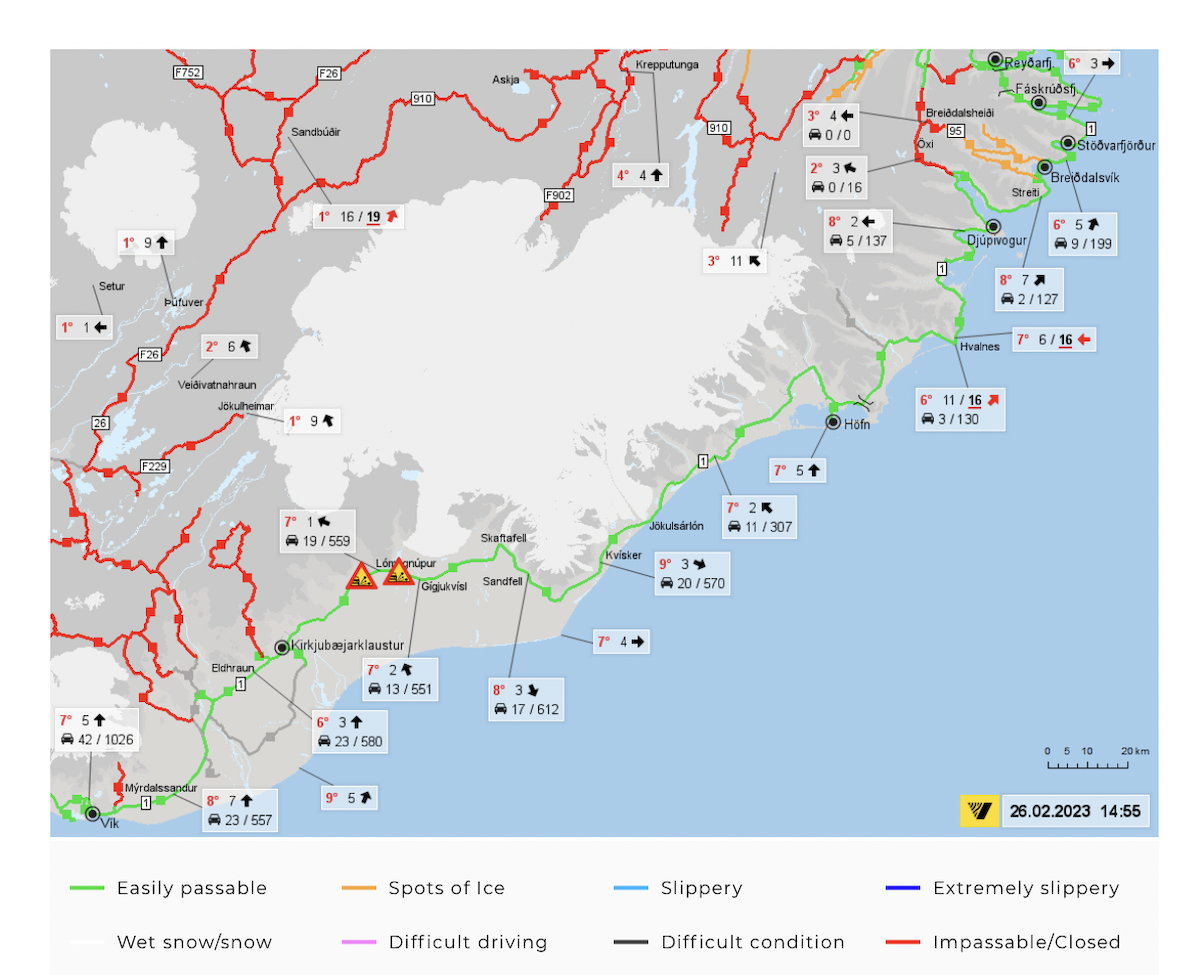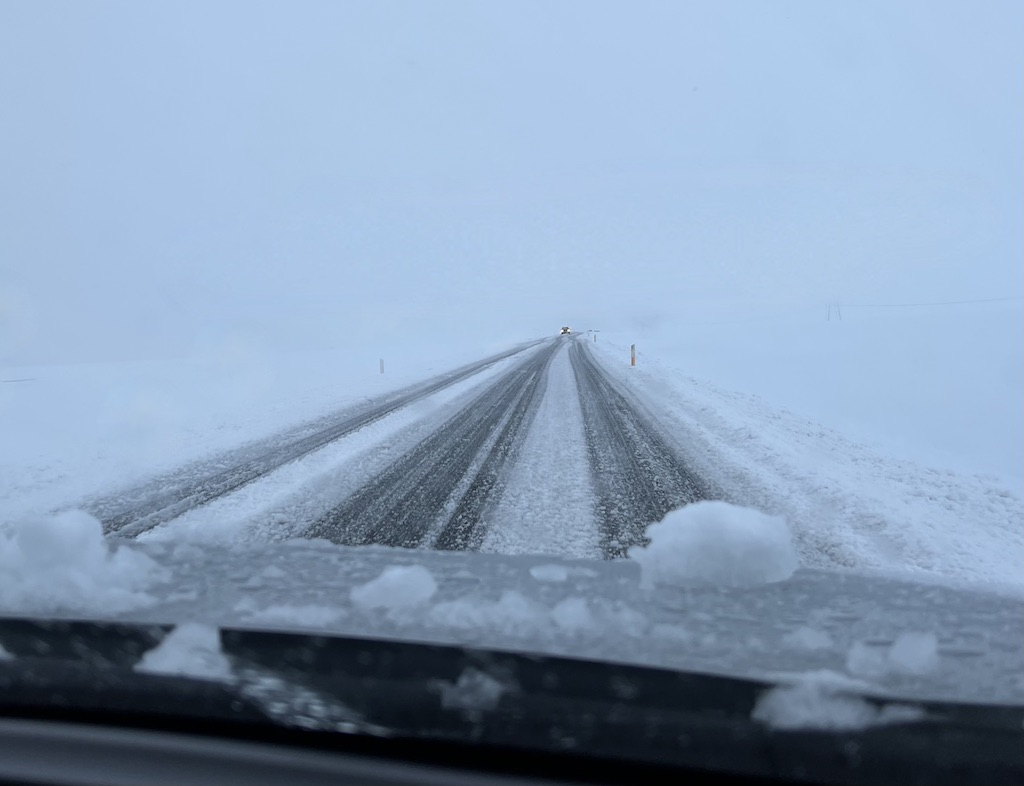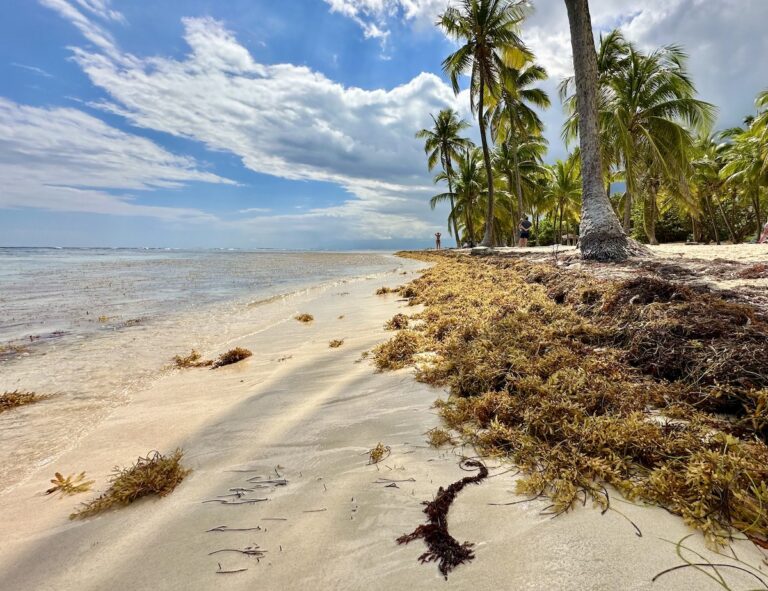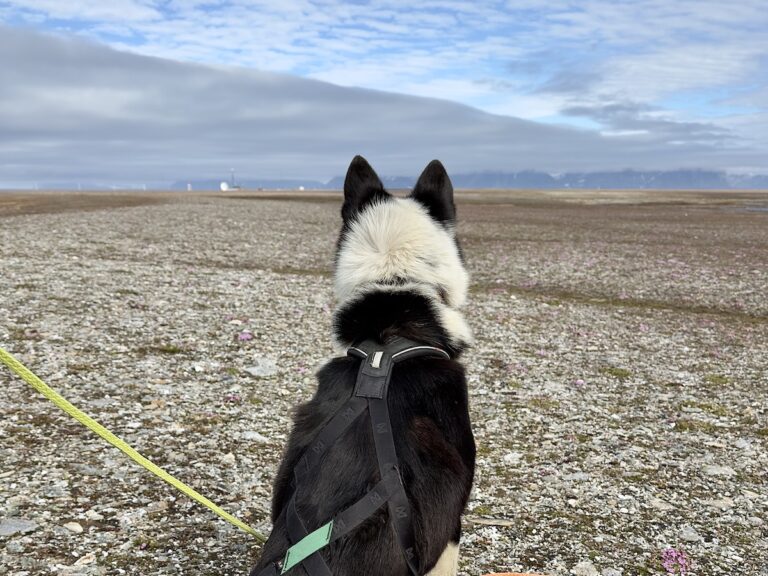15 Essential Tips for Driving Iceland in Winter

Affiliate Disclosure: This post on Winter Driving in Iceland contains affiliate links. If you click a link and make a purchase, I may receive a small commission at no cost to you. All opinions are entirely my own.
Are you planning an Iceland winter driving adventure? There are many benefits to choosing to self drive Iceland in the winter including less crowds at the major attractions and the freedom to move about on your own schedule.
There are also several things to do in Iceland in the winter that you simply cannot experience in the summer months – like visiting the sensational blue ice caves and snowmobiling on a glacier. With those long dark nights, winter is also the best time in Iceland to see the Aurora Borealis.

As I write this, I have just returned from a second big adventure involving self driving in Iceland in winter. It was such an exhilarating and worth-while travel experience, but I definitely came back with some advice to share. The following post contains my top tips on how to drive in Iceland in winter as well as several important need-to-know facts about winter in Iceland.
Please use the following menu to find what you need quickly. I’ve also included a 3 minute compilation video of some of the beautiful places you may want to see on your epic adventure!

SAVINGS ALERT
Renting a car in Iceland? I highly recommend Lava Car Rental. (See Trustpilot reviews.) Get free 4G Hotspot WiFi (1500 ISK/day value), by using TARAWIFI at checkout. Tick the box for “4G WiFi” when selecting your additional features and the fee will be removed upon checkout.
SELF DRIVE ICELAND IN WINTER VIDEO
ICELAND IN WINTER – THE NEED-TO-KNOW
1. DAYLIGHT HOURS
On my first trip driving in Iceland in winter I missed the memo on how few hours of daylight you actually have to work with. There is no point hitting the road early if you are just going to arrive at that incredible waterfall in the dark! Here is a list of the sunrise/sunset times from November to February in South Iceland (Reykjavik).
- November 1/30: Sunrise (9:10am/10:42am), Sunset (5:11pm/3:49pm)
- December 1/31: Sunrise (10:45am/11:20am), Sunset (3:47pm/3:40pm)
- January 1/31: Sunrise (11:19am/10:12am), Sunset (3:42pm/5:10pm)
- February 1/28 Sunrise (10:09am/8:37am), Sunset (5:15pm/6:44pm)
As you can see, timing is everything. At the end of December, you have about 4.5 hours of daylight to work with. By the end of February, however, you have over 10 daylight hours.
2. ICELAND WINTER WEATHER
THE TEMPERATURE
Despite being called “Iceland”, the temperatures in this northern nation during the winter may not be quite as cold as you might expect. The temperature range in the winter months typically runs between -8°C (18°F) and +8°C (46°F) with the average hovering around +/-2°C.
Note: I’m sharing the temperature range for the south of Iceland since few visitors do the Ring Road (that circumnavigates the country) or travel to the northern regions in the winter. That said, if you do plan to visit the north of Iceland in winter, you can expect to experience even colder temperatures.
THE WIND
What is extremely unique about Iceland weather in the winter is the intense winds with occasional gusts of over 160km/hr (100mph). It is the kind of wind that at times can feel like it might push your vehicle off the road and forces you to grasp the steering wheel with a true white-knuckle grip!
THE CHANGEABILITY
There are few places in the world where the weather seems to change so rapidly and so often. In Iceland during the winter, it is not uncommon to have sun, rain, sleet, hail and snow all within the span of an hour. You really need to be prepared for all conditions even when you set out on a bright and sunny day.
15 SELF DRIVE ICELAND WINTER TIPS
1. RENT THE BIGGEST VEHICLE YOU CAN AFFORD
If you have looked into renting a vehicle in Iceland, you probably already know that they are very expensive. I know it’s a little painful from a budget perspective, but if at all possible, I strongly encourage you to rent a big, heavy vehicle with good clearance and 4WD to handle the ice, snow, and wind.
All rental vehicles in Iceland are required to have studded tires in winter, but having a heavier vehicle with all wheel drive makes for a much more comfortable driving experience.

True Story: On my most recent Iceland winter trip with my friend Sarah, we rented a 4WD Suzuki Vitara. In retrospect I wish we had upgraded to a Toyota 4 Runner or something like it. It wasn’t about the traction on the roads, it was about the intense gusts of wind that often threatened to push us into the oncoming lane. (A 4Runner weighs twice as much as a Vitara.) On numerous occasions we saw cars off the road, and they were always small, light vehicles.
See also: Tips for Renting a Car in Iceland

SAVINGS ALERT
Renting a car in Iceland? I highly recommend Lava Car Rental. (See Trustpilot reviews.) Get free 4G Hotspot WiFi (1500 ISK/day value), by using TARAWIFI at checkout. Tick the box for “4G WiFi” when selecting your additional features and the fee will be removed upon checkout.
2. TEST YOUR VEHICLE
Before leaving the rental car lot with your vehicle, do a quick test to make sure everything is in good working order (windshield wipers, defrost/heat, windshield fluid, headlights, brakes). Also be sure to always drive with your headlights on during the winter in Iceland, day and night, as visibility can be poor.
3. BRING THE RIGHT GEAR
At minimum, you will want to have an ice scraper in your vehicle. Better yet, a portable travel shovel in the unlikely event that you do happen to get stuck. (Our SUV from Lava Car Rental came with an ice scraper in it.) In a pinch, many gas stations have small stores attached that sell not only snacks, but also some imperative winter gear.
You will probably be well dressed in warm winter gear, but you may wish to have some extra stuff in case your mitts, socks etc. get wet on excursions. Personally, I always keep one of those small, folded emergency blankets in the pocket of my ski jacket.
4. CHECK THE CONDITIONS
If you didn’t pick up on this already, the weather in Iceland in winter can be extremely unpredictable. On 2 out of 7 days on our most recent Iceland winter trip (Jan./Feb.), we had storms come up that either closed roads or threatened to close roads along the South Coast.
It is imperative that you plan your route ahead of time and check the weather and road conditions regularly. The best place to do this is Vedur.is (weather) and Safe.is (road conditions).
I am including a screenshot below from Safe.is (from a particularly good day). When you are heading out, pay particular attention to orange roads because they can quickly change to red (closed) and leave you stranded.

If you do find yourself in a dangerous situation, 112 is the number to call. Safe.Is also recommends that you log your route with them ahead of time.
5. KEEP YOUR PHONE CHARGED
How are you going to call 112 if you get into trouble? You are going to use your fully charged cell phone!
Be sure to start you day with a fully charged battery and ideally carry a large back up battery with you. If you are using a GPS, you may not have an extra port to charge your phone with so that is where the back up battery comes in handy. Furthermore, if you will be using your phone to take photos and videos on your Iceland winter trip, this can drain your battery quickly.
6. STAY FUELED UP
The further away you get from major towns such as Reykjavik, the more spread out the gas stations become. For peace of mind, keep that tank topped up.
Note: I did not notice a lot of EV charging stations around South Iceland, except in Reykjavik. I’m also not a huge fan of EVs in harsh winter conditions (range anxiety is bad enough without gale-force winter winds to contend with). I highly recommend renting a conventional vehicle for this type of trip.
7. MIND THE SPEED LIMITS
The speed limits in Iceland are 50km/h in towns, 70km/h approaching towns, 80km/h on gravel roads and 90km/h on less populated paved roads.
While these are very reasonable speeds during the summer months, in winter conditions you are definitely going to want to slow down. The photo below is on a 90km/h road that we were taking about about 50km/h. Keep in mind that with these winter Iceland driving conditions, you will want to build in more time to get to your destination.

When driving in Iceland in the winter, visibility can be limited and roads can be icy. Always keep a safe distance from the vehicle in front of you (at least twice your normal distance).
8. MAKE FLEXIBLE PLANS
The reality of winter travel in Iceland is that roads can close, sometimes foiling your travel plans for the day. If you can manage it, I would suggest planning one or two activity-free days into your schedule so that you have some room to move things around if needed.
When you have good weather, I would try to see the attractions you most want to see first, just in case the conditions change and you have to cut your day short.
On our very first day exploring South Iceland, we received an email from both our hotel and our car rental company recommending that we head straight to our accommodations because a big storm was on the way. We also had to move our blue ice cave tour out a day due to closed roads on our scheduled day.
9. KNOW THE ROAD SIGNS
Take a few minutes before setting out on your Iceland winter road trip to familiarize yourself with road signs that you may not have encountered before. The most common one that we came across while driving around the South Coast was the “Single Lane Bridge”. For obvious reasons, this is a pretty important one to know.

10. MIND THE WIND
Although I addressed this earlier in the post, I need to bring up the wind again. Not only is it an issue when you are driving (in that you need to keep a really firm grip on the steering wheel), it can also cause other problems.
When it is windy, you need to park strategically – and by this I mean parking into the wind (wind blowing towards your vehicle). While it will make it difficult to open your door, you avoid the risk of your door blasting open and incurring damage. Yes, this really happens in Iceland. Sometimes car doors even get totally ripped off their hinges!
“Blown up doors”, as they call them in Iceland, are almost never covered in rental car insurance policies and can cost upwards of 350,000 ISK ($2700 USD) to repair. Furthermore, blowing sand and ash in high winds can cause damage to a vehicle’s paint finish. (This, you can get insurance for!)
11. INSURE TO THE MAX
While on the topic of insurance, I want to encourage you get the full insurance suite for your Iceland rental car. Your insurance should include protection for blowing sand and ash, as well as spraying gravel – both which can lead to vehicle body damage.
For the record, Iceland is the only country in the world where I buy all the insurance. (Normally I would consider it a fear-mongering cash grab.) With such unusual weather, however, vehicle body damage occurs frequently. And like almost everything else in Iceland, car repairs simply cost more than in most other places. Think double.
True Story: On my first trip to Iceland in the summertime, my husband and I were underinsured. By some miracle, and despite a large truck spraying gravel all over our car, we were spared from any additional charges upon returning our rental car. A couple beside us, however, was not so lucky. They were told that they would need to pay the equivalent of about $2000 USD for paint damage. Since then, I have encouraged every one I know to always get all the insurance in Iceland.
12. UNDERSTAND WINTER DRIVING
To be honest, I don’t think I would suggest a self driving Iceland winter itinerary to someone not already at least somewhat comfortable with driving on ice and snow. Add to that the occasional gale-force gust of wind and it can lead to some exciting (and by that I mean slightly scary) moments.
That said, if you have driven on ice and snow before, driving in Iceland in winter is a pretty exhilarating experience. Need some quick winter driving tips? Check out this video from Consumer Reports.
The most important thing to know is that excessive speed, quick braking and quick acceleration are the enemy. Or, as they say in the linked video, “Drive as if you are trying to balance a cup of coffee in your lap without spilling it”.
13. STAY ON THE MAIN ROADS
To stay safe while driving in Iceland in the winter, stick to the major routes. These roads are the first to get plowed, salted, sanded etc. when conditions are not ideal. Winter is not the time in Iceland to seek out those “hidden gems” that are way off the beaten track.
As you research what it’s like to drive in Iceland, you will probably come across videos of 4 wheel drive vehicles taking gravel roads into remote regions and roaring through rivers. These rough roads are called F-roads and they criss cross the more remote regions of the country. These roads, however, are closed in the winter months. Don’t worry though – I assure you that you are still going to have a very exciting Iceland driving adventure, even sticking to the main roads!
14. DON’T STOP ON THE ROAD

If you want to make a stop on an Iceland road (like for those gorgeous Icelandic horses), find a safe place to pull off. It is actually prohibited to stop on the side of the road in Iceland. This is due to the fact that visibility can sometimes be poor and this can actually be quite dangerous for other drivers.
15. WATCH FOR ANIMALS

While we have encountered more animals on or near the road while driving in Iceland in the summer, it is always a good idea to keep an eye out for them. In a country with almost as many sheep as residents, there always seem to be a few about!
BEFORE YOU GO
I really hope I didn’t make you nervous about driving in Iceland in the winter. It is really a wonderful, wonderful experience…I just want you to be well prepared! If you have any questions, please feel free to reach out to me, either in the comments, or by messaging me on Instagram.
MORE ON ICELAND
- The 10 Best Things to do in Iceland in Winter
- The Ultimate Iceland Winter Packing List
- A Guide to Renting a 4×4 in Iceland
- Iceland Westman Islands Guide
- Iceland Ring Road Driving Guide
- 10 Beautiful South Coast Iceland Hotels
- The Best Things to do in East Iceland
- The Guide to Renting a Car in Iceland
- 20 Best Things to do in Reykjavik with Kids
- Puffins in Iceland – Where to Find Them






